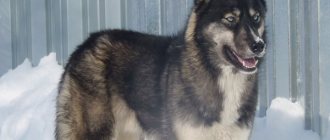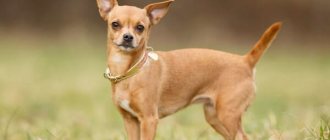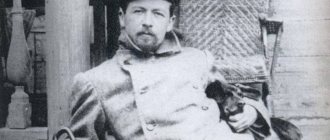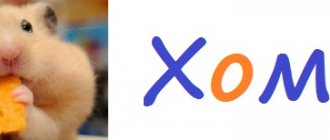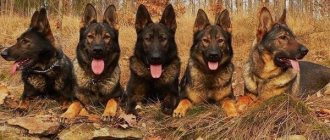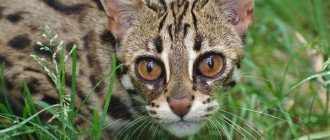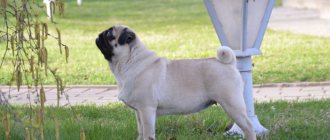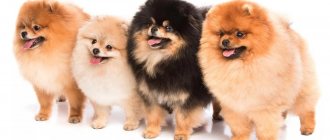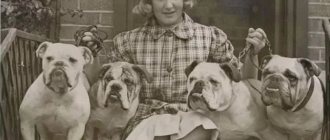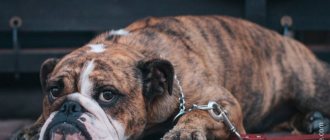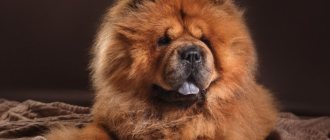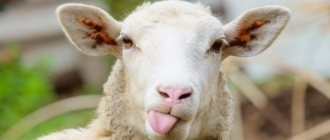The first two species are common in Eurasia, while the blackfoot is found only in North America. Domesticated ferrets are often called ferrets, freds or ferrets from the English ferret. According to the biological classification, ferrets, together with weasels, minks and ermines, belong to the species Mustela of the family Mustelidae (Mustelidae).
Steppe polecat
The largest representative of related species. The length of its body reaches 56 centimeters, the tail is up to 18 cm, and its weight is up to two kilograms. The animal's fur is characterized by a long and thin coat, through which the light underfur is clearly visible. It is distinguished by the darker color of the fur on the paws, the tip of the tail and the presence of a dark mask on the muzzle. It feeds on small rodents, large insects, frogs, and hunts snakes.
Detailed description of the breed: Steppe ferret
Forest polecat
Somewhat smaller than its steppe brother. The body length is up to 46 cm, the tail length is up to 16 cm, the weight of an adult is about 1.5 kg. Color varies from white and red to black. The most common color variant is black-brown, in which the belly, paws and tail are much darker than the rest of the body. Just like the steppe ferret, it feeds on rodents, mainly mouse-like ones, frogs, and hunts birds and snakes.
Detailed description of the breed: Forest ferret
Black-footed ferret
Found only in North America, listed in the Red Book. Almost completely exterminated in Canada and the USA. Now it is bred in captivity and released into its natural habitat. It is distinguished by its small body size and body weight of about 1 kg. The fur is thick, low, darkening towards the tips. The paws, the end of the tail and the mask on the face are almost black. The main food in nature are gophers.
Detailed description of the breed: Black-footed ferret
Classification by color
Thanks to breeding work, the colors of ferrets are extremely diverse. Until 2012, ferrets were classified according to standards developed by the AFA (American Ferret Association). This method is based on the distribution of ferrets according to three main characteristics:
- color;
- color colors;
- distribution of white spots.
Colors:
- Albino.
- Sable.
- Black sable.
- Black.
- Champagne.
- Chocolate.
- Cinnamon.
- White black-eyed (-).
By color colors we mean a pattern on the body of a ferret, formed by the distribution of pigment in the hairline. According to AFA standards, the following colors are distinguished:
- Siamese (siamese),
- Roan (roan),
- Solid
- Standard.
According to AFA standards, it is customary to distinguish the following locations of white spots:
- Blaze (flash, white spots on the head).
- Panda (panda).
- Mitts (mittens).
In addition to the AFA classification, there are standards developed by the Russian Ferret Breeders Association (RFBA) in 2012. The table below contains RFBA ferret colors with photos and names.
The complete absence of pigment in the hair and iris of the eyes is a rare and interesting phenomenon. Despite the obvious difference from their colored counterparts, the albino ferret is no different in either care or maintenance.
| Photo | Name | Description |
| Albino | There is no pigment in the hair and iris of the eyes. | |
Types of ferrets
First, let's figure out what types of ferrets there are, and by what criteria they are distinguished.
Stepnoy
This is the largest and most prolific species. It is found throughout Eurasia, right up to the Far East. The body reaches a length of 55 cm. The tail is 15-18 cm. The steppe ferret weighs 2 kg. Light weight allows the animal to move gracefully and silently. There are up to 18 puppies in a litter.
The wool is colored unevenly. The color is usually dark, ranging from brown to almost black. The underfur is lighter. The belly, paws and tip of the tail are colored darker than the rest of the parts. There are dark spots in the shape of a mask on the face. The guard hairs are short and not particularly thick. It feeds on insects, rodents, snakes, and frogs.
Forest
The distribution area is throughout Western and Eastern Europe, to the foothills of the Urals. It is considered the “progenitor” of domestic breeds. Body length is up to 40-46 cm. The tail is at least 16 cm in length. Weight – 1.5 kg. The female brings up to 6 cubs in a litter. Puppies have a mane that disappears as they grow.
In nature, white and red ferrets are found - the result of interspecific mating of forest and steppe ferrets.
The coat color is brown or black, the underfur is lighter and has a yellow tint. There is a white “mask” on the muzzle. The belly and paws are darker than the main color. Like the steppe ferret, it feeds on mice, gophers, snakes and insects. In addition, forest ferrets hunt for birds.
Read more about this type of ferret here.
American (Blackfoot)
The rarest species. Habitat: North America. Much fewer “Europeans”. Body length – 39-42 cm. Weight – from 0.3 to 1 kg. Rarely found in the wild. The species is on the verge of extinction and is listed in the Red Data Books of North American countries. Zoologists continue to try to restore the population by breeding animals in captivity and releasing them into their natural habitat.
The fur is beautiful, light shades - from cream to yellow. The belly, paws and tip of the tail are darker than the main color, they are almost black. High density of fur and down. The “mask” on the muzzle is black.
Domesticated ferrets
Domesticated forest ferrets are called ferrets. These are large animals, 55-60 cm long and weighing about 2 kg. The word "fretki" is of Polish origin. Also in use are the following names:
- Furo are albino ferrets.
- Honoriki is a hybrid of a mink and a ferret.
- Thorzofrets are a hybrid of wild and domestic ferrets. We don't know what he looks like.
Albino furo ferrets
Hybrid of mink and ferret
Among ferrets, thanks to breeding work, there are many colors. These animals produce offspring from representatives of their group and from wild individuals.
Ferrets have an innate lack of fear of humans, and sleep in their lives takes up to 20 hours a day.
Pastel group
Animals of this group are characterized by very light fur. Unlike albinos, their fur is colored from light beige to light brown. At the same time, the fur is colored unevenly, creating a tinted effect. What stands apart in this group is the cinnamon color, in which the hair has a pronounced orange or reddish tint.
Light pastel (Champagne) Pastel (Pastel) Dark pastel (Chocolate) Cinnamon (Cinnamon)Coat types
The color of the coat, nose and eyes is not the only difference between domestic ferrets. These animals can have different types of fur. Working to produce different colors and patterns, breeders developed ferrets with long hair—it stays fluffy without much maintenance.
Wool options:
Angora. The guard hairs reach a length of 7-12 cm. Males have longer hair than females, so they look fluffier. Ferrets with Angora hair have a distinctive feature - their nostrils have an unusual twisted shape.
Half Angora. In semi-angora ferrets, the hair reaches a length of 5 cm, on the belly - 3.5 cm. The phenotype of semi-angora ferrets is assessed based on the results of spring molting, since 3.5 cm corresponds to the length of the coat of normal-coated ferrets in winter.
Normal coat. Hair length in winter is 3.5 cm, in other times – 3 cm. Normal-haired animals have a dense and dense underfur.
Angora ferret
Half Angora
Normal coated ferret
Group of pastel selfies
The group is characterized by the fact that the spine (regardless of its color) is completely colored. Due to this, the frets of the group lack shading. The base color ranges from dark brown in chocolate to snowy white in Dew.
Chocolate self Chocolate solid Champagne self Cinnamon self DewLocation of white spots
One of the criteria for classifying domestic ferrets is the location of the white spots on the body.
There are three options:
- Flash. A flash is a color in which white spots are located on the head. The color of the fur of the eyes and nose does not matter.
- Panda. Pets of this type look luxurious. They have a white head, shoulders and chest. The tips of the paws are also white. The paws themselves are dark, the tail is also dark. There may be dark circles around the eyes. The nose is pink, the eyes are dark brown, rarely ruby. The disadvantage of this type is the frequent occurrence of deafness. Breeders are now working to eradicate this genetic defect.
- Mittens/socks. The mitten/sock type includes ferrets with white spots located on their paws. Any color of fur, eyes and nose.
Ferrets have poor vision, but they compensate for this deficiency with acute hearing and an excellent sense of smell.
Markings
Marked (Marked) The top hair has up to 40% dyed and from 60% white. Silver (Silver mitt) Differs from the previous one only in a larger percentage of dyed fur. This type includes exclusively mother-of-pearl group ferrets. Roan (Roan) An even larger amount of colored spine and a smaller amount - white. Panda (Panda) Has a white neck and head with a fairly dark body color. Blaze (Blaze) Characterized by the presence of a continuous and even stripe on the head Mitt Distinguished by the white tips of the paws and tail. Point. In this group of ferrets the contrast between the main color of the fur on the body and limbs is most noticeable. Badger Unlike Blaze ferrets, the white stripe on the head has intermittent or uneven outlines .Milk Mouse (Milk mouth) Characterized by the presence of a pronounced white spot around the nose and eyes Pinto Panda (Pinto panda) Similar to the Panda, but with lighter main fur. Sometimes there are dark “glasses” around the eyes, giving the ferret an even greater resemblance to a real panda. Harlequine Harlequins include domestic ferrets whose colors are difficult to classify, as well as those animals whose color has a pronounced asymmetry.Author: Mayboroda Yuri
Colors
Ferrets with a clear pattern are especially popular among domestic ferrets. All the variety of colors is combined into four main groups:
Standard. The guard hairs and underhairs are pigmented. White color is no more than 10%. Coat color – any. The color can have different saturation - this feature distinguishes standard-colored ferrets from monochromatic ones.
Roan. With this coloring, half of the hair of ferrets is white. The white color of the hairs is evenly distributed along the entire length, or is present only at the base. Along with white hair, gray hair may be present, alternating with pigmented hair. There is a mask on the face.
Siamese. Like Siamese cats, ferrets of the same name have a tail and paws that are darker than the body, and a V-shaped “mask” on the face. The nose is light and may have specks on it. The mask also comes in a T-shape. The color of "Siamese" varies from light brown to dark brown. There are other shades - for example, champagne.
Solid. There is no white fur. The guard hairs and down hairs are colored equally. Any colour. The intensity of the color is the same throughout the body, while all other colors of the paws, abdomen and tail are richer. The animals do not have masks of this color. The eyes match the color of the fur.
Interesting Facts
- Frets' sleep can last up to 20 hours,
- If you get a ferret in a rural area, it can kill domestic chickens or regularly destroy their eggs,
- Ferrets were used to photograph Princess Diana's wedding ceremony from a certain angle where photographers could not reach,
- Also, thanks to their unique flexibility, ferrets helped in the construction of Boeing aircraft,
- Like skunks, ferrets can emit an unpleasant musky odor when threatened.
- If necessary, the ferret can dig a hole 5 m deep within an hour.
The following are NOT KUSTELIDS
- Mongoose, including dwarf mongooses and meerkats. Although they also have anal scent glands and a similar shape, the 34 members of the family Herpestidae are native to Africa, South Asia and Southern Europe.
- Skunks! In recent years they have been officially classified as Mephitidae. Most of the 13 different species are found from Canada to the northern parts of South America. They certainly have the most developed scent glands of all!
- Civets (aka civet cats) and fossa cats (known from the cartoons Madagascar) are viverrids from the viverrid family. They grow in the dense forests of Africa, Asia and some islands.
Nutrition
Ferrets are exclusively nocturnal animals. Only very strong hunger can force one to interrupt daytime sleep and go hunting during daylight hours.
The following representatives of the animal world become prey, namely what ferrets eat in nature:
- what the ferret eats first of all are small rodents: rats, hamsters, mice, gophers, moles and ground squirrels, hares and rabbits;
- lizards or small amphibious reptiles;
- They easily destroy found egg clutches, and sometimes attack birds.
Animals do not eat plant foods due to their digestive characteristics. However, a ferret can get nutrients from, say, fruit by eating small herbivores. It is also worth noting that in difficult situations, if it is impossible to find anything that ferrets usually eat, they are able to eat the carcasses of already dead animals.
What do they eat in nature?
Since the ferret is a predator, its diet consists of food items of animal origin. Therefore, his diet includes:
- Insects and invertebrates. When an animal is hungry, it will never refuse worms and other small animals.
- Reptiles, in the form of lizards and snakes, including poisonous ones.
- Rodents, as well as small animals such as rabbits and hares.
- Birds, however, a ferret will never pass by a bird's nest without checking it for eggs or chicks.
The ferret does not eat fish or fruit at all, since its digestive system is not adapted for plant components. The animal receives all the necessary nutrients from its basic diet.
Interesting to know! Ferrets, like many other animals, store food for the winter. To do this, predators store the food they have caught in a secluded place.
The ferret hunts mainly at night, although under certain conditions, when there is a lack of food, it can hunt during the day. If food is very tight, then the ferret can easily eat carrion.
Reproduction and offspring
Sexual maturity in ferrets occurs quite early, maximum within 1 year of life. The breeding process of ferrets takes about six months, and the beginning of the process depends on living conditions. Steppe ferrets begin to take care of the birth of future offspring already in March, and forest ferrets - somewhere in mid-spring or even early summer.
These animals do not have signs of a mating ritual, so the mating process takes place vigorously and one might think that the ferrets are fighting. As a result of this process, males can cause minor injuries to females. This is where the role of males in the appearance of future offspring ends, since they do not take any part in raising the future generation.
It is important to know! The female carries her future offspring for one and a half months. From 4 to 20 puppies are born, depending on the number of births the female has. The puppies weigh within 10 grams and are absolutely helpless and blind.
The female feeds her cubs with milk for a maximum of 3 months, but already at the age of one month meat appears in their diet. After about a month, babies' eyes open. After stopping milk feeding, the puppies begin to hunt together with their mother. After six months of life, the offspring begins their own life, independent of their parents.
Intensity
Color intensity is determined by the level of color saturation of the ferret's overall appearance relative to other ferrets with a similar color. The intensity depends on the level of brightness of the color and the length of the top part of the coat. The color intensity can change seasonally (in summer the coats are darker and in winter they are lighter) with age. The intensity can also be genetic; in one litter there can be puppies with different intensities of the same color.
- Standard
– intensity accepted as zero value. The value is not written. - Light
/ Light – color intensity is lower than standard. - Dark
/ Dark – color intensity is higher than standard. - White
/ White – zero color intensity (brightness ~ 100%), the color of the ferret is completely white. Due to the complete disappearance of the color that defines the color, this intensity is identified as a separate DEW color. The value is not written. - Black
/ Black - the color of the ferret is completely black. This value is obtained due to an increase in the length of the upper part of the coat and a decrease in the brightness of the lower part of the coat in the black group of colors. The minimum accepted value for the length of the upper black part of Black's coat is 60%. There are three colors in the black group that convey their specific shades: yellow-golden (Gold Black), brown (Sable Black), pure black (Pearl Black).
Ferret (ferret)
The ferret is an extraordinary representative of the mustelid family, which has a flexible mind, agility and perfectly adapts to any conditions. The first ferrets were domesticated many years ago, and for centuries they have lived next to humans and brought him considerable benefit.
In the modern world, ferrets are very popular as pets. But before you get yourself a “pocket” predator, you need to weigh the pros and cons. Caring for ferrets is quite simple, but some pet lovers are put off by the specific smell, nocturnal lifestyle and unusual diet.
Range, habitats
All three wild species are found in Eurasia, North America and the northwestern part of the African continent. The steppe ferret has chosen open areas and avoids mountains, forests, and crowded places. It can be found in steppe or semi-desert regions of Mongolia, Kazakhstan, China, some areas of Europe and Asia.
Important! The ferret is not found in the wild. The animal's gentle nature and lack of hunting skills simply will not allow it to survive in such conditions.
The black ferret, on the contrary, prefers forests, ravines and banks of reservoirs, and sometimes populated areas. It does not go too far into the thicket, being content with the edges and areas with sparse vegetation. Its habitat is Europe and part of Africa. Their black-footed relative lives in the forests and prairies of North America. It is also found in the mountains, where it climbs several thousand meters above sea level.
Natural enemies
Many of their natural enemies live in the same territory as ferrets, such as:
- Foxes and wolves that are capable of hunting ferrets, especially in winter, when they do not particularly have to choose victims for food.
- Birds of prey, in the form of night owls and golden eagles.
- Wild cats, for whom catching a ferret is not a problem at all.
- Large snakes, although they are not always able to cope with such a mobile animal.
An equally dangerous enemy of the ferret is humans, who cause serious harm to the population of these useful animals, not only exterminating them, but also surviving from their natural habitats.
Interesting fact! To protect itself from natural enemies, the ferret emits an unpleasant odor, which is generated by special glands located at the base of the tail.
As a result of human economic activity, populations of small animals that are part of the diet of these predators are declining, which threatens the existence of ferrets no less than other problems.
Links
Useful
See what “ferret” is in other dictionaries:
ferret - furo, polecat, stinky Dictionary of Russian synonyms. ferret noun, number of synonyms: 15 • bzdyuh (13) • stinky ... Dictionary of synonyms
FERTLE - male, Nov. Beloz. island on a river or lake. | Ferret and ferret, · belittles. Horik, predatory animal Mustela putorius, old. Dhor, south Thor, Psk. bzdyuh; rotten, smelly. Ferret, ferret fur. Ferret hole. | Ferret, aphid, clothes moth. To the east Sib.... ... Dahl's Explanatory Dictionary
Ferret - or polecat (in Siberia kurna) is caught both with a gun and dogs, and with various traps. In the first case, industrialists, usually together, walk with dogs along streams and other places where X. are kept; dogs search for them by instinct and either themselves... ... Encyclopedia of Brockhaus and Efron
FERTLE - alive. from the order of carnivores. X. lives in the forest zone and is dark brown in color; in the steppe it is yellow. X. feeds almost exclusively on small rodents: mice, voles, ground squirrels, etc., which it destroys in huge quantities (steppe X.); sometimes... ...Agricultural dictionary-reference book
Ferret - If you dream of a ferret, you will find yourself in some kind of dirty story. If you smell a ferret on your clothes in a dream, you will notice that your behavior has become deliberately rude, and your affairs are turning out to be the most unsatisfactory... ... Large universal dream book
Ferret - If you dream of a ferret, it means you will find yourself in some kind of dirty story. If you smell a ferret on your clothes in a dream, it means that you will notice that your behavior has become deliberately rude, and your affairs are turning out the most... ...Miller's Dream Book
ferret - see ferret ... Etymological Dictionary of the Russian Language by Max Vasmer
Ferret - ferret m. 1. Predatory fur-bearing animal of the weasel family; ferret 2. The fur of such an animal. 3. decompression Products made from such fur. Ephraim's explanatory dictionary. T. F. Efremova. 2000 ... Modern explanatory dictionary of the Russian language by Efremova
ferret - ferret ferret; m. Predatory fur-bearing animal of the family. mustelids; polecat (common in Europe and North America). // The fur of this animal. ◁ Ferret, oh, oh. X-hole. X. fur. X hat ... Encyclopedic Dictionary
ferret - 1) a prisoner making a tunnel; 2) prostitute; 3) lover of sleep... Thieves' jargon
Source
